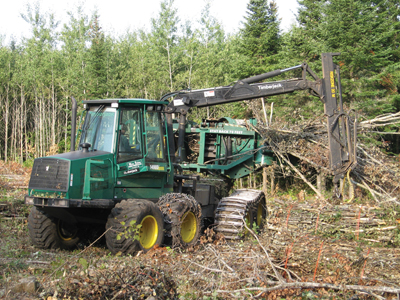
Operational Research: Loggers’ Input Key
May 27, 2009
By Canadian Biomass
Many studies have examined the harvest of biomass (dead and
nonmerchantable wood) for energy production or to reduce fire hazards,
but few have included the lessons learned from the loggers.
Many studies have examined the harvest of biomass (dead and nonmerchantable wood) for energy production or to reduce fire hazards, but few have included the lessons learned from the loggers. Researchers from the Institute for Agriculture and Trade Policy, the University of Wisconsin, and the University of Minnesota have done just that in their study Harvesting Fuel: Cutting Costs and Reducing Forest Fire Hazards through Biomass Harvest, released in June 2008. The study assessed economic and operational issues faced by the loggers, allowing specific recommendations to improve efficiency and reduce cost.
 |
|
|
|
The selective biomass harvest took place in Superior National Forest, northeastern Minnesota, which comprises 1.2 million ha of multi-use forest. Excess fuel loads have accumulated in large areas of this forest and pose a serious fire risk. Instead of conventional fuel treatment methods in which biomass is crushed or piled and burned, would it be cost effective to harvest and sell the biomass?
To answer this, loggers harvested biomass in nine sites, and researchers monitored the pre- and post-harvest quantity of biomass and economic data on harvesting, forwarding, and processing. Because biomass harvest is new in Minnesota, various harvest prescriptions and goals and harvesting and transportation systems were tested. Harvesting and transportation involved cutting and piling by hand or using machinery, forwarding of loose or bundled biomass, grinding, transporting by chip van or trailer, and in one case, biomass harvest was combined with some roundwood harvest. The loggers had little previous experience in biomass harvest.
Not all effective
The researchers found that biomass harvest was more cost effective than conventional fuel reduction in only one of nine sites. Optimization models showed that cost effectiveness could be achieved for additional sites, but varied with the equipment used and hauling distance (less than 160 km recommended).
There was huge variation in the removal of the prescribed biomass. The greatest harvest efficiency was 75% of stems less than 2.5 cm in diameter at breast height (dbh, 1.8 m above the ground) and 94% of stems greater than 2.5 cm dbh, but most harvests were much lower. Few dead standing trees, or snags, were removed, even when they were a harvest target.
The variation in biomass harvest was caused by two main factors. First, biomass was inaccessible in many sites because of the topography or arrangement of overstory trees. Second, the removal or damage of large trees during biomass harvest could result in fines because of federal laws regarding timber harvest in National Forests. More flexible site prescriptions are recommended to address these issues.
Based on their experiences, the loggers had many suggestions to improve the efficiency of selective biomass harvesting. These were grouped into harvesting and delivery factors and planning and coordination factors, with tips found below.
Picture source: Institute for Agriculture and Trade Policy
Harvesting and Delivery
|
|
Print this page